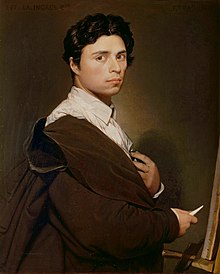Dominique Ingres
| Jean-Auguste-Dominique Ingres | |
|---|---|

Self-portrait at age 24, 1804 (revised c. 1850), oil on canvas, 78 x 61 cm, Musée Condé
|
|
| Born |
Jean-Auguste-Dominique Ingres 29 August 1780 Montauban, Languedoc, France |
| Died | 14 January 1867 (aged 86) Paris, France |
| Known for | Painting, drawing |
| Notable work |
Louis-François Bertin, 1832 The Turkish Bath, 1862 |
| Movement | Neoclassicism |
Jean-Auguste-Dominique Ingres (French: [ʒɑnoɡyst dominik ɛ̃ɡʁ]; 29 August 1780 – 14 January 1867) was a French Neoclassical painter. Although he considered himself to be a painter of history in the tradition of Nicolas Poussin and Jacques-Louis David, by the end of his life it was Ingres's portraits, both painted and drawn, that were recognized as his greatest legacy.
A man profoundly respectful of the past, he assumed the role of a guardian of academic orthodoxy against the ascendant Romantic style represented by his nemesis, Eugène Delacroix. His exemplars, he once explained, were "the great masters which flourished in that century of glorious memory when Raphael set the eternal and incontestable bounds of the sublime in art ... I am thus a conservator of good doctrine, and not an innovator." Nevertheless, modern opinion has tended to regard Ingres and the other Neoclassicists of his era as embodying the Romantic spirit of his time, while his expressive distortions of form and space make him an important precursor of modern art.
Ingres was born in Montauban, Tarn-et-Garonne, France, the first of seven children (five of whom survived infancy) of Jean-Marie-Joseph Ingres (1755–1814) and his wife Anne Moulet (1758–1817). His father was a successful jack-of-all-trades in the arts, a painter of miniatures, sculptor, decorative stonemason, and amateur musician; his mother was the nearly illiterate daughter of a master wigmaker. From his father the young Ingres received early encouragement and instruction in drawing and music, and his first known drawing, a study after an antique cast, was made in 1789. Starting in 1786 he attended the local school École des Frères de l'Éducation Chrétienne, but his education was disrupted by the turmoil of the French Revolution, and the closing of the school in 1791 marked the end of his conventional education. The deficiency in his schooling would always remain for him a source of insecurity.
...
Wikipedia
